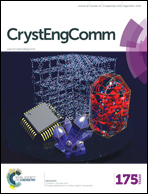Solvent effects on nucleation of disodium guanosine 5′-monophosphate in anti-solvent/water mixtures
Abstract
The influence of the solvent on the nucleation of disodium guanosine 5′-monophosphate (GMPNa2) in eight methanol (ethanol)–water mixtures and at three supersaturation levels at 293.15 K was investigated. The interfacial free energy, the critical size for nucleation, and the number of molecules were calculated using equations re-derived from the classical nucleation theory. GMPNa2 nucleation involves not only a primary nucleation process but also the conversion from a homogeneous to a heterogeneous process. The transformation experiment indicated that the nucleation of GMPNa2 follows the two-step model. A surface entropy factor (fb) was proposed to relate the solvent composition and interfacial free energy in order to explain the solvent effects on the nucleation process. Although the fb values can be used to judge the crystal growth mode, nucleation and growth cannot be separated, since pure primary nucleation does not occur for this compound. The fb values clearly increased with increasing solvent content and decreasing supersaturation. For the homogeneous process in a methanol–water system, regular crystals can be formed only when fb > 5, regardless of the supersaturation, as was observed for solvent contents of 40 mol% and 30 mol% (S = 1.83 and 1.70, respectively). These results can help select a suitable solvent system and its composition during anti-solvent crystallization.



 Please wait while we load your content...
Please wait while we load your content...